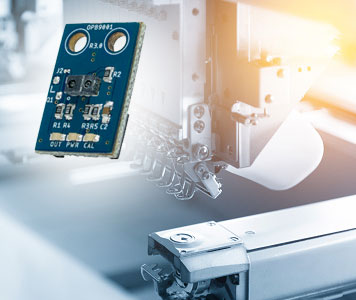
Free shipping within the continental US over $50. Conditions apply

Please contact your salesperson for assistance.
Free shipping within the continental US over $50. Conditions apply

Please contact your salesperson for assistance.
Free shipping within the continental US over $50. Conditions apply
- home
- Semiconductors
- Optoelectronics
- Optical Sensors & Switches Optical Sensors & Switches
Optical Sensors & Switches
Find the Right Optical Sensors & Switches
If you are looking for optical sensors and optical switches, find them all from reputed manufacturers, at Future Electronics. Our optical sensors transform light rays into readable electronic signals in the circuit, while optical switches provide control over signal flow by switching from one circuit to another. Our collection includes transmissive optical sensor, reflective optical sensors, photointerrupter, interrupter, photologic slotted optical switched and more.
Optical Sensors & Switches
What are an Optical Sensor and an Optical Switch?
An optical sensor converts light rays into electronic signals. It measures the physical quantity of light and then translates it into a form that is readable by an instrument. An optical sensor is generally part of a larger system that integrates a source of light, a measuring device and the optical sensor. This is often connected to an electrical trigger. The trigger reacts to a change in the signal within the light sensor. An optical sensor can measure the changes from one or several light beams. When a change occurs, the light sensor operates as a photoelectric trigger and therefore either increases or decreases the electrical output.
An optical switch enables signals in optical fibers or integrated optical circuits to be switched selectively from one circuit to another. An optical switch can operate by mechanical means or by electro-optic effects, magneto-optic effects as well as by other methods. Optical switches are optoelectronic devices which can be integrated with integrated or discrete microelectronic circuits.
Types of Optical Sensors & Switches:
There are many different kinds of optical sensors & switches and at Future Electronics we stock many of the most common types categorized by type, wavelength, forward (drive) current, range, power dissipation, packaging type and maximum CE voltage. The parametric filters on our website can help refine your search results depending on the required specifications.
The most common sizes for wavelength are 640 nm, 700 nm, 800 nm, 940 nm and 950 nm. The maximum CE voltage can range from 5 V to 70 V, with the most common optical sensor & switch chips having a maximum CE voltage of 30 V.
Optical Sensors & Switches from Future Electronics:
Future Electronics has a full selection of optical sensors & switches from several manufacturers that can be used for a digital optical switch, MEMS optical switch, optical proximity sensor, HDMI optical switch, reflective optical sensor, optical position sensor, 1x2 optical switch, high speed optical switch or any other optical sensor & switch circuit. Simply choose from the optical sensor & switch technical attributes below and your search results will quickly be narrowed to match your specific optical sensor & switch application needs.
If you have a preferred brand, we deal with several. You can easily refine your optical sensor & switch product search results by clicking your preferred optical sensor & switch brand below from our list of manufacturers.
Applications for Optical Sensors & Switches:
Optical sensors can be found in the energy field to monitor structures that generate, produce, distribute, and convert electrical power. The distributed and nonconductive nature of optical fibres makes optical sensors perfect for oil and gas applications, including pipeline monitoring. They can also be found in wind turbine blade monitoring, offshore platform monitoring, power line monitoring and downhole monitoring. Other applications include the civil and transportation fields such as bridge, airport landing strip, dam, railway, airplane, wing, fuel tank and ship hull monitoring.
Among other applications, optical switches can be found in thermal methods which vary the refraction index in one leg of an interferometer in order to switch the signal, MEMS approaches involving arrays of micromirrors that can deflect an optical signal to the appropriate receiver, piezoelectric beam steering liquid crystals which rotate polarized light depending on the applied electric field and acousto-optic methods which change the refraction index as a result of strain induced by an acoustic field to deflect light.
Choosing the Right Optical Sensor & Switch:
When you are looking for the right optical sensors & switches, with the FutureElectronics.com parametric search, you can filter the results by various attributes: by Range (450 to 1120 nm, 1.2 m, 1.18 m, …), Wavelength (635 nm, 940 nm, 950 nm,…) and Power Dissipation (from 0.75 mW to 100 W) to name a few. You will be able to find the right chip for your optical sensor & switch circuit such as an optical proximity sensor, digital optical switch, MEMS optical switch, HDMI optical switch, 1x2 optical switch, high speed optical switch, reflective optical sensor or optical position sensor.
Optical Sensors & Switches in Production Ready Packaging or R&D Quantities:
If the quantity of optical sensors & switches required is less than a full reel, we offer customers many of our optical sensor & switch products in tube, tray or individual quantities that will avoid unneeded surplus.
In addition, Future Electronics offers clients a unique bonded inventory program that is designed to eliminate potential problems that could arise from an unpredictable supply of products containing raw metals and products with long or erratic lead times. Talk with your nearest Future Electronics branch and find out more on how you and your company can avoid possible shortages.

